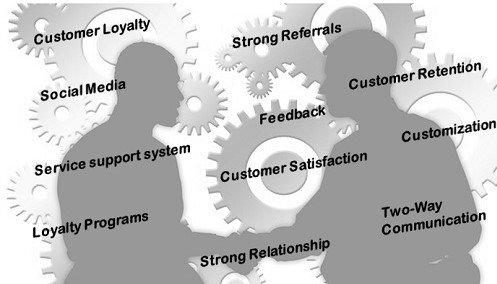Social marketing is a proven strategy for influencing behavior in a sustainable and cost-effective manner, combining principles from commercial marketing and the social sciences. Quite different from social media marketing, it promotes a behavior or lifestyle that is geared toward making a societal impact. Read on to learn more about how this marketing technique works.
Social marketing is marketing that aims to affect social change rather than directly benefiting a brand. It creates awareness of a specific problem or causes through standard marketing strategies and attempts to persuade an audience to change their behavior.
In order to effect the intended transformation, social marketing “sells” a behavior or lifestyle that benefits society rather than a commodity. The fundamental goal is always to enhance the public good. Instead of demonstrating how a product is superior to competitors, social marketing “competes” against negative beliefs, habits, or actions.
This sort of marketing is frequently utilized for causes such as:
Health and safety concerns, including:
- Anti-smoking
- Anti-drug
- Promoting physical activity and healthy eating
- Driving safely
- Railway station security
Environmental factors, including::
- Anti-deforestation
- Anti-littering
- Concern for Endangered Species
Social activism, such as:
- Bringing to light the challenges that people of color, persons with disabilities, and others endure, and then empowering people to fight against the processes that cause inequity
- Anti-bullying
- overcoming gender stereotypes
Who starts these marketing campaigns? The majority of social marketing efforts are run by non-profit organizations and charities. They are also run by government groups, highway safety coalitions, and emergency services (police, fire, and ambulance). However, if you run a commercial business, social marketing is not out of the question. Commercial brands will occasionally launch social marketing initiatives for causes they care about.
The Importance of Social Marketing
What is the significance of social marketing? Consider “conventional” goods or service advertisements. You are not persuaded to purchase a product or service just based on an advertisement (in fact, you tune out the vast majority of ads you see).
But how can a well-designed advertisement catch your attention? It either takes an unexpectedly innovative turn or makes you laugh, cry, or ponder. Not every advertisement persuades you to try the product or service it offers, but the finest ones use creativity or emotion to urge people to do so.
It’s the same with social media marketing. People dislike being told what they should do. They may not be persuaded by news or public service announcements regarding a particular social issue. Alternatively, they may be unaware of the problem or its scope.
Some people may also find it difficult to engage in socially useful behavior, or they may believe they are incapable of resolving a problem on their own. Alternatively, people may struggle to break a long-standing habit (i.e. someone trying to quit smoking, or someone who uses disposable water bottles regularly).
A well-executed social marketing campaign, on the other hand, draws attention and raises awareness of a social issue through creativity and emotion. Most importantly, it gives a compelling, uncomplicated way to make the world a better place, and it elevates this positive action above any “competing” conduct. Social marketing can successfully “sell” a desirable behavior using these elements.
People want to make a difference in the world, therefore social marketing with a charitable giving component is highly effective. They’re eager to donate; it’s simply an issue of where.
Features Of Social Marketing: The Four Ps
The four “Ps” stand for product, pricing, location, and promotion, and they are often referred to as the “marketing mix.” You must establish these variables before designing your social marketing plan and keep them in mind throughout the process.
Product
The “product” in social marketing is the desired social activity and the advantages it provides. Make sure this modification is presented as appealingly as feasible… This could involve labeling the opposite behavior as negative. Clarity is also essential. Make sure your audience understands your “product” and its benefits fast and readily.
Price
Reduce the “price” your audience perceives they must “pay” for the intended social action to occur.
This cost is not solely monetary. It’s also about decreasing people’s trouble, time, and psychological/emotional expenses. So, while creating a social marketing strategy, consider (and investigate) the barriers that prevent your target audience from engaging in the habit.
Then, devise intuitive, workable solutions to these challenges. For example, if your campaign aims to encourage greater activity in your neighborhood but there are few safe outdoor locations and indoor class rates are prohibitive, try offering free indoor fitness sessions.
Place
Where do you want your audience to do the desired action? How can you reach them in ways that make the action easier to conduct in that area (and thus more appealing than competing behaviors)? Is it necessary to recruit peers from your target audience as “ambassadors” to make the campaign more accessible to your target audience?
Consider the following examples of “place”:
- If you set up a hotline for teens, make it available 24 hours a day, seven days a week, by phone, text, and internet messaging.
- If you want to drive food bank donations, attempt a campaign in a grocery shop with donation bins at the store exits. Consider the following FeedSA example:
- If you want to encourage customers to use reusable bags in stores, charge them for each disposable bag they require and offer reusable bags for a nominal fee (that customers can keep bringing back and using at no cost to them). Take it a step further and put messages such as “plastic bags damage marine life” on the disposable bags while making the reusable bags beautiful and appealing to use.
- Include a URL, QR code, or live contribution link on your campaign advertising if you’re doing a donation campaign.
Promotion
This one connects all four “Ps.”
What platforms and outlets can assist you to reach out to your target audience and capture their attention to your social marketing campaign?
What is social media? Television? Radio? Is it a sign, a billboard, or an installation? Concerts, expos, and community days, for example? Guerrilla marketing?
How will you draw attention to the product (activity), the low price, and the location of the action?
Tips and Strategies for Social Marketing
How will you artistically convey the “4 Ps” to your audience while also striking an emotional chord? And how can you work to maximize your long-term impact? Consider these methods and tips for the greatest results.
#1. It may take multiple rounds of study to properly minimize “price.”
Before you build your campaign, you’ll need to conduct extensive research to determine what hurdles prevent your target audience from completing your desired behavior (“price”). Survey your target population online, by phone, or in print. Keep in mind that finding the “price” may need multiple surveys and talks. After all, as you speak with more folks, you’ll gain a deeper understanding of the most typical roadblocks.
After identifying the “price” and brainstorming methods to reduce it, try hosting focus groups to assess how people react to the identified problem and potential solution.
Create a slogan and captivating graphics, as well as consider developing a simple but memorable symbol, to serve as potent “triggers” that encourage action and stick in the minds of your audience.
#2. Create a memorable slogan.
“Only you have the ability to avert forest fires.” “This is your drugged-up brain.” “We’ve got this!” The three iconic social marketing efforts mentioned at the beginning of the article all featured memorable slogans. Writing a tagline is essential for your own social marketing effort. As previously stated, you want your audience to grasp the behavior you’re looking for and how to act on it as soon as feasible. So it makes perfect sense to distill that idea into a campaign slogan—a concise, intriguing line that will stick in the minds of your target audience. Even better if you can attach a mention to the benefits of the desired action.
#3. Everything revolves around the visuals.
Imagery that surprises or shocks audiences can be a potent motivator, especially if it depicts the problem or the negative consequences of undesirable actions. To optimize the impact of your visuals, carefully select your marketing media.
Visuals become much more compelling when they are tailored to take advantage of the “location.” Consider the image of the starving child provided by FeedSA above. Consider the Amnesty International image below, which puts people face to face with a child soldier in their own area. It instills a strong desire to assist the youngster and to speak out against this violation of human rights.
#4. Consider making a straightforward but distinctive emblem.
Simple yet now-iconic symbols, such as the pink ribbon for breast cancer awareness, are used in some of the most effective social marketing initiatives. Sometimes that sign is a person (think Smokey Bear). If you can construct a basic yet memorable symbol or figure that is related to your campaign, your campaign behavior will be more likely to “stick.”
Social Media Marketing
Social media marketing (SMM) is the use of social media—the platforms on which users create social networks and share information—to grow a company’s brand, improve sales, and drive website traffic. SMM features purpose-built data analytics that allows marketers to track the performance of their efforts and uncover even more opportunities to engage, in addition to providing companies with a tool to communicate with existing consumers and reach new ones.
What is the Process of Social Media Marketing?
As social media platforms such as Facebook, Twitter, and Instagram grew in popularity, they transformed not only how we connect with one another, but also how businesses can influence consumer behavior—from promoting content that drives engagement to extract geographic, demographic, and personal information that makes messaging resonate with users.
#1. SMM Action Plan
The more specialized your social media marketing (SMM) approach, the greater its effectiveness. Hootsuite, a top social media management software supplier, suggests the following action plan for developing an SMM campaign with an execution structure and performance metrics:
- Align SMM aims with specific business objectives.
- Discover your ideal customer (age, location, income, job title, industry, interests)
- Perform competitive analysis of your competitors (successes and failures)
- Examine your present SMM (successes and failures)
- Make an SMM content delivery calendar.
- Create world-class content
- Monitor performance and tweak your SMM strategy as appropriate.
#2. Customer Relationship Management (CRM)
When compared to traditional marketing, social media marketing has several distinct advantages, including the fact that SMM has two types of interaction, both of which enable targeted customer relationship management (CRM) tools: customer-to-customer and firm-to-customer. In other words, whereas traditional marketing typically tracks customer value through purchase activity, SMM can track customer value both directly (through purchases) and indirectly (through product referrals).
#3. Shareable Material
Businesses can use the increased interconnection of SMM to create “sticky” content, which is a marketing phrase for appealing content that attracts customers at first glance, convinces them to buy things, and then makes them want to share the content. This type of word-of-mouth advertising not only reaches a previously untapped audience but also carries the implicit endorsement of someone the recipient knows and trusts, making the creation of shareable content one of the most essential ways that social media marketing promotes growth.
#4. Earned Media
Customer-created product reviews and recommendations are the most efficient way for a firm to reap the benefits of another type of earned media (a word for brand exposure from any manner other than paid advertising).
#5. Viral Marketing
Viral marketing, a sales tactic that aims to drive the rapid spread of word-of-mouth product information, is another SMM strategy that relies on the audience to generate the message. When a marketing message spreads well beyond the initial intended audience, it is considered viral—a very simple and affordable approach to promoting sales.
#6. Customer Segmentation
Because customer segmentation on social media marketing (SMM) is far more sophisticated than on traditional marketing channels, businesses can ensure that their marketing resources are focused on their particular target consumers.
What is The Difference Between Social Marketing and Social Media Marketing?
- The goal of social marketing is to change people’s attitudes and behavior for the betterment of society. The goal of social media marketing is to raise brand/service awareness among prospective customers.
- Understanding the target audience, creating relationships with them, and then personalizing the campaign to them are the focus of social marketing. Social media management focuses on selling a product/service to new customers, drawing them to the product/service, and convincing them to sell it.
- Social marketing is limited in scope and focuses on a single region or behavior. Social media marketing targets a bigger market because it contacts customers through online platforms such as social media.
- The success of social marketing is determined by the social campaign and the social relationships that individuals have. The success of SMM is dependent on social media participation, analytics on sales made, views, and so on.
- A human with a face and a name is used in social marketing. In contrast, a faceless, nameless corporate account is used in social media marketing.
Is Social Marketing Good?
Social marketing is a strategy that has numerous advantages for both corporations and public relations specialists. When public relations professionals employ a social marketing strategy, they can expand their knowledge and broaden their experience.
What is the main purpose of social marketing?
Instead of focusing on people’s beliefs or levels of awareness, social marketing campaigns aim to alter or sustain their actions. It is not social marketing if your main objective is to spread information or alter people’s perspectives.
What makes social marketing programs fail?
A typical problem that prevents social marketing programs from getting off the ground is poor management of stakeholders, especially in regard to power imbalance and unmanaged expectations.
Why do marketers need social marketing?
Since anyone may join a social media network, businesses can keep tabs on their customers and prospective customers. Having a deeper understanding of the demographics of their ideal consumer base allows marketers to tailor their efforts more effectively.
What is the first step in social marketing?
When it comes to social marketing, the first step is to identify the issue at hand, as well as your objectives, your intended audience, and their perspective on the matter. Clarify what the issue is. In social media terms, this is ground zero.
Who performs marketing?
When asked who engages in marketing, the simple response is “everyone!” But that’s a rather glib response, and it doesn’t really help. Let’s stop for a second and think about the various approaches to marketing employed by various businesses.
In Conclusion,
Social marketing is marketing that encourages social change rather than selling a product. It sells a behavior that helps society rather than a product. Through images and appealing slogans, well-executed social marketing employs creativity and provokes emotions to inspire action. If you intend to use social marketing to address an issue or raise awareness, make sure to explicitly define your campaign’s “four Ps” before you launch.
Frequently Asked Questions
How is social marketing used?
Social marketing uses commercial marketing approaches to encourage the adoption and maintenance of healthy behaviors.
Who is the father of social marketing?
Philip Kotler is the father of social marketing
Who introduced 4 Ps of marketing?
E Jerome McCarthy introduced the 4 Ps of marketing.
Related Articles
- COVERED CALL Explained: Understanding Covered call Formula With Examples
- Brand Strategy: How to Develop an Effective Brand Strategy with Examples
- Best Email Marketing Campaign Examples (+ Detailed Guide)
- SOCIAL MANAGEMENT TOOLS: Meaning, Free Tools and Guide
- CAMPAIGN MANAGEMENT TOOLS: Free Tools and Application
- International Marketing: What You Need To Know[+Free Tips]






